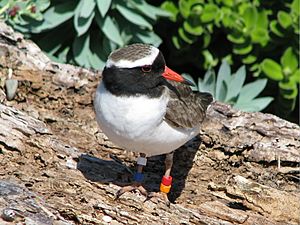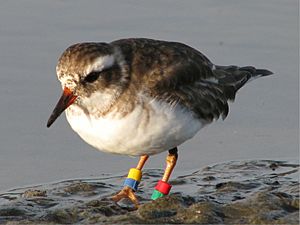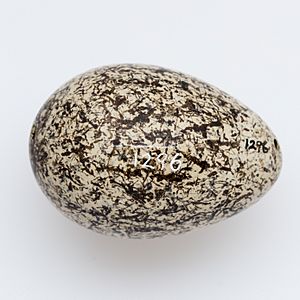Shore plover facts for kids
Quick facts for kids Shore plover |
|
|---|---|
 |
|
| Shore plover male | |
| Conservation status | |
| Scientific classification | |
| Genus: |
Thinornis
|
| Species: |
novaeseelandiae
|
The shore plover (Thinornis novaeseelandiae) is a small bird found only in New Zealand. People also call it the shore dotterel or by its Māori name, tuturuatu. These birds used to live all along New Zealand's coast. Now, they only live on a few islands far from the mainland. It is one of the rarest shorebirds in the world. There are only about 200 of them left.
Contents
Shore Plover Family Tree
Shore plovers were first put into a group called Charadrius. Now, scientists usually place them in the Thinornis group. Another bird in this group is the hooded plover. Some experts still think the shore plover belongs in the Charadrius group. More genetic studies are needed to figure this out for sure.
What Does a Shore Plover Look Like?
The Thinornis novaeseelandiae has a brown back and a white belly. Males have a black mask on their face, while females have a brown mask. A clear white stripe goes around its head, just under its brown cap. Its legs and the tip of its bill are orange. The orange color is brighter in male birds.
Where Do Shore Plovers Live?
These birds used to live all over the New Zealand coast. Scientists have found old shore plover bones far inland near rivers. This shows they once lived away from the sea too. In the 1800s, people saw shore plovers on both the North and South Islands.
But by the 1870s, they had disappeared from the main islands. They only survived on the Chatham Islands. Animals like wild cats and Norway rats were brought to New Zealand. These new animals hunted the shore plovers, causing their numbers to drop.
Shore Plover Reproduction
Shore plovers are special because they nest under cover. They might nest under driftwood, plants, or even in burrows under rocks. This helps protect their eggs and chicks from birds that hunt them, like skuas. In the past, they also had to hide from the laughing owl and the New Zealand falcon.
However, nesting in these hidden spots makes them easy targets for mammals like rats. This is one reason why their numbers went down.
In the early 1990s, the Department of Conservation (DOC) started a special program. They began raising shore plovers in captivity. They started with only 6 to 10 pairs of birds. Since then, over 400 young birds raised in captivity have been set free into the wild.
Protecting Shore Plovers
Shore plovers are an endangered bird. There are only about 200 of them left in the world. For a long time, they only lived on one island called Rangatira in the Chatham Islands.
Since then, some birds have been moved to other islands. These islands include Mangere Island (Chathams), Mana Island (near Wellington), and Motutapu (near Auckland). These islands are free of predators like rats and cats.
In 1937, there were about 70 breeding pairs. Their home was made a reserve in 1954. The number of birds went up and down. In 1982, there were only 40 pairs, but by 2010, there were 94 pairs. In 2016, there were 66 breeding pairs in the wild. Most of these (56 pairs) were still in the Chatham Islands. DOC wants to increase the population to 250 birds living in five different places.
In 2007, DOC moved young birds raised in captivity to Mana Island. These birds started breeding within months! But a single Norway rat got onto the island. It caused the population to drop from 87 birds to just 10.
Birds were also moved to Waikawa (Portland Island) starting in 2000. In 2012, the population there also crashed because of a Norway rat. Only 20 birds were left. Twelve eggs were saved and moved to Mana Island.
In 2012, 42 captive-bred shore plovers were released onto Motutapu Island. This island had all its mammal pests removed in 2010. The birds often flew away from Motutapu. By 2015, only five were left. So, 19 more were released. The breeding population on Motutapu grew from one pair in 2015 to three pairs in 2016. These birds are the easiest for people to see.
More young birds have been released in recent years. Six were released in 2018. In 2019, 25 more were released. In 2020, five young birds were moved to Mana Island during the COVID-19 lockdown.
See also
 In Spanish: Chorlitejo de las Chatham para niños
In Spanish: Chorlitejo de las Chatham para niños




